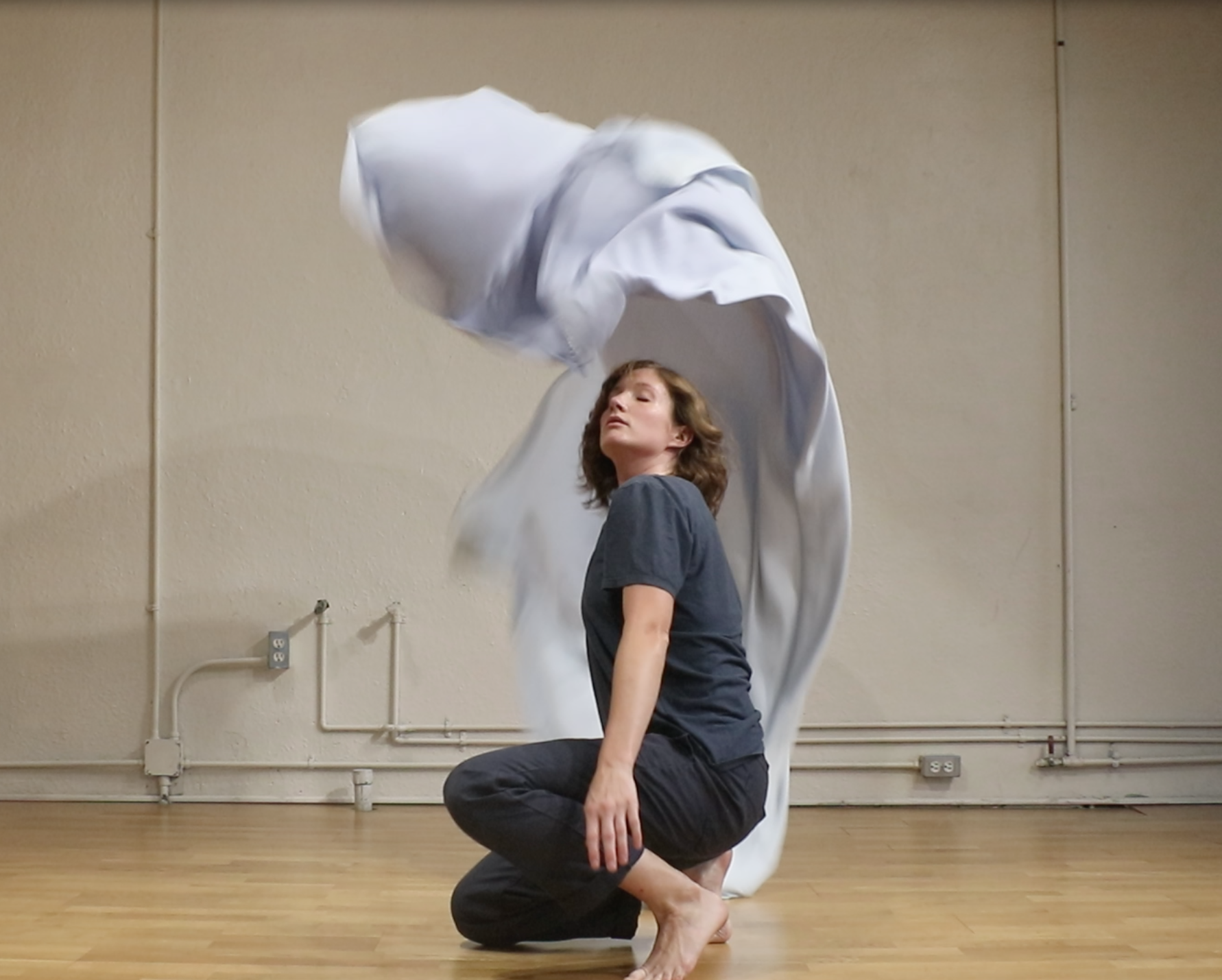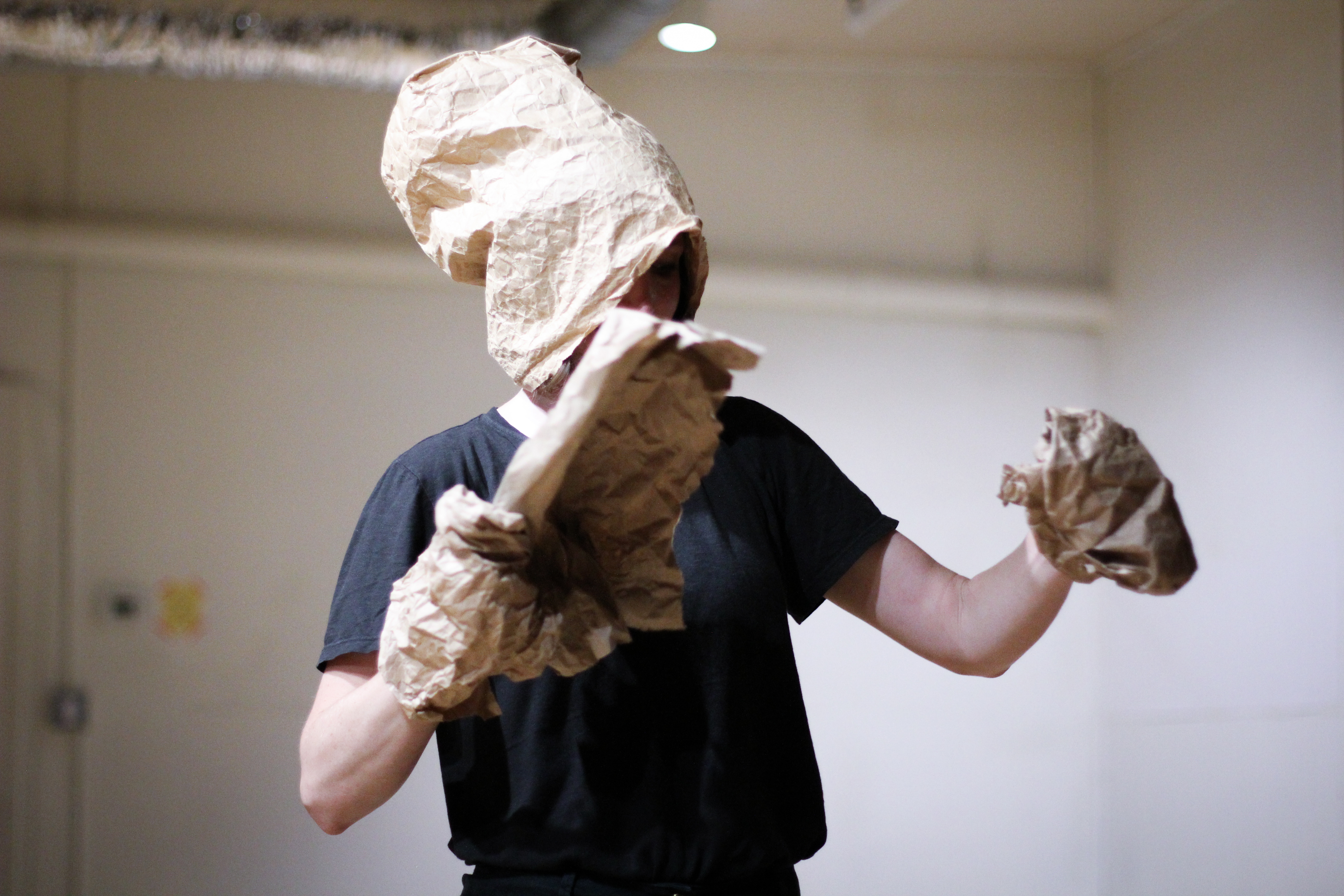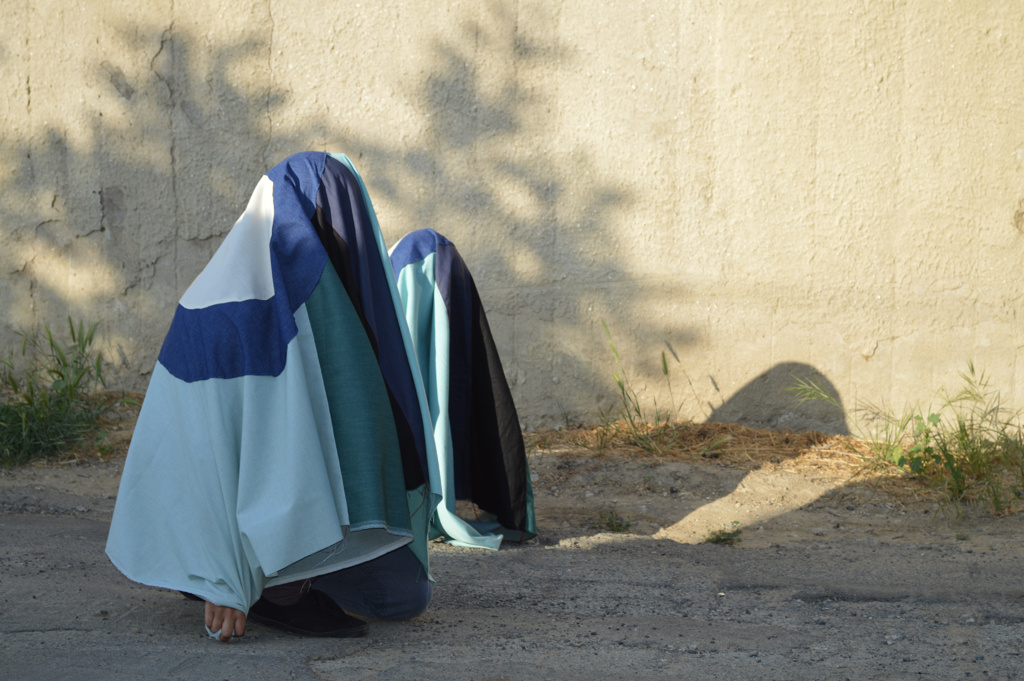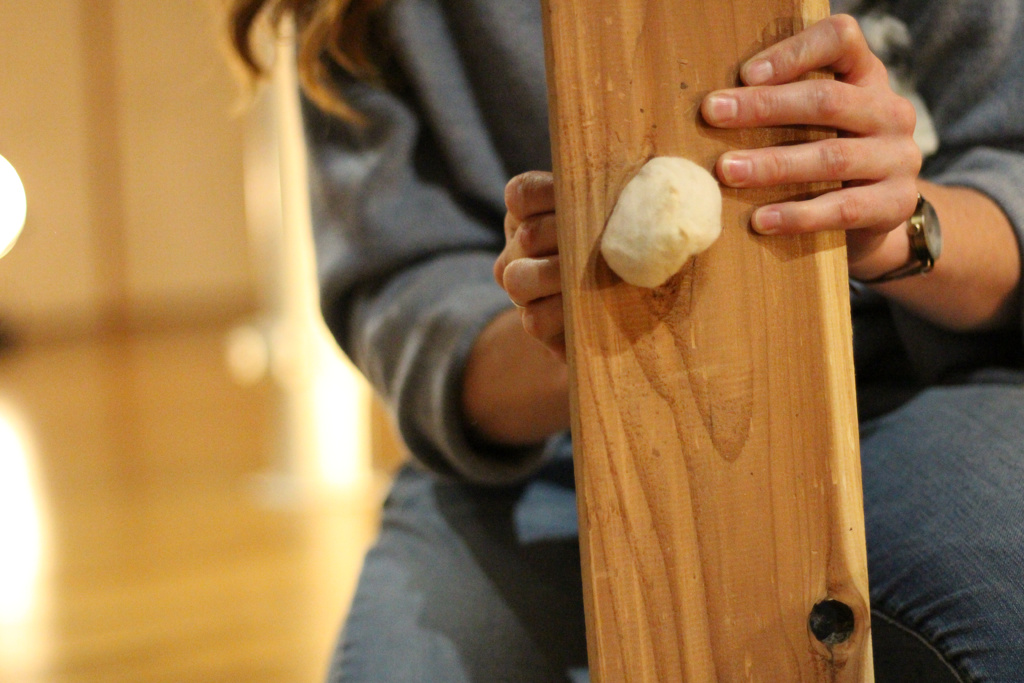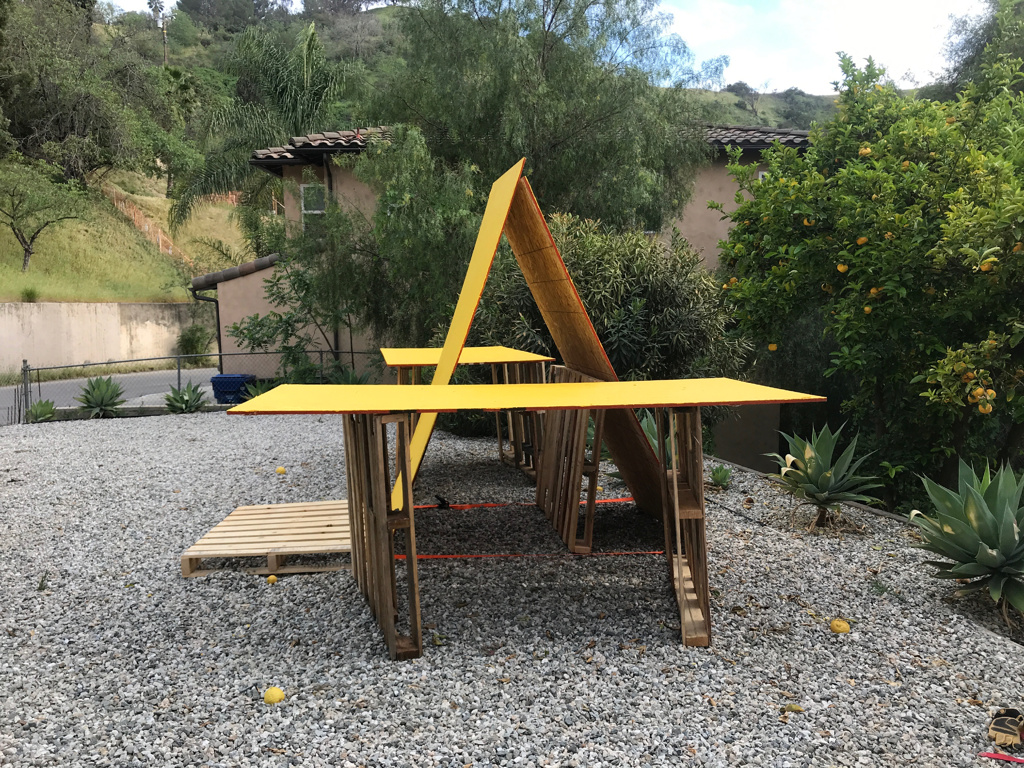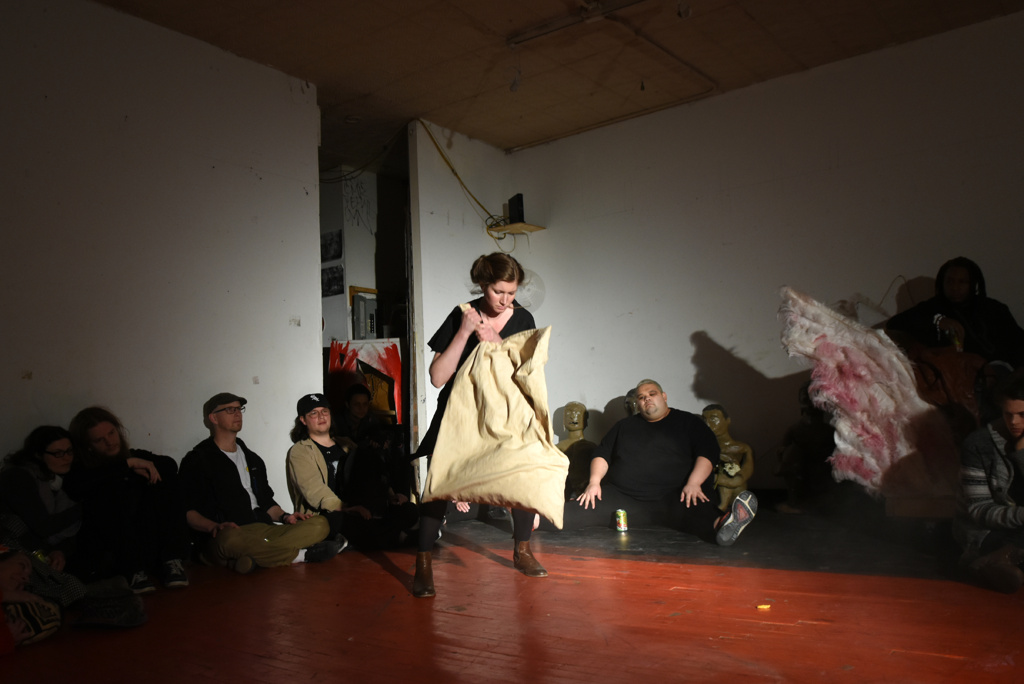Statement
I create body-based performance art, using movement, everyday objects, sound, text and site-specific development. I am interested in perceptions of the ordinary, material capabilities, and audienceship.
Objects and materials serve both in their stillness as images and also in movement and liveness with performance. They make sound, disappear, transform, and reveal. My focus is not solely with the body or with objects, but with the engaged and active space in between the two. I work with everyday materials that are at once familiar and yet not themselves. As an artist and designer, the tactile and sensorial qualities are important both functionally and experientially. My multidisciplinary processes include making clothing, building furniture and constructing objects.
Movement, dance, and choreography is created with scores for action, duration, image, and improvisation. These constraints are supported by somatic study, and anatomical and energetic research. Through this complexity I question the tools in which we use to navigate between the inner and the outer.
Improvisation is a practice of observing, listening and of participation. It is a place to experience acknowledgement, unknowing, the effort to understand, and the willingness to live.
I am interested in blurring the boundaries of the performance space and acknowledging the physical exchange between performer and viewer. My work considers spatial capabilities of ‘a stage’ as it lives in the theatre, the gallery, and private and public space. I move between the intimacy of one-on-one performances and the larger visibility of public space works.
Bio
Amelia Charter was born in Madison, Wisconsin, USA. She is a performance artist, teacher, and writer. She earned her BA in Performance and Directing from Fort Lewis College in Durango, Colorado, was co-founder of Denver Performance Research (2009 - 2012), and received an MFA and fellowship in Performance from the School of the Art Institute of Chicago (2014). Her works have been featured in Los Angeles at The Electric Lodge, Paloma Street Studio, and Pieter Performance Space - in Chicago at Sector 2337, Defibrillator Gallery, Mana Contemporary, Co-Prosperity Sphere, and Links Hall - in Indianapolis at The Sugar Space and The Oilwick - in Philadelphia at the Museum of Art and Mascher Space Cooperative - and at Kriti Gallery in Varanasi, India.
Amelia Charter participates in artist collectives that focus on movement somatics, voice work, improvisation, and healing as radical practices. She currently lives and works in Los Angeles as a teacher, organizer, and designer, supporting queer, feminist systems, process-oriented projects and experiential learning. She continues her passion for carpentry, building furniture, outdoor stages, and other elements for community members in Southern California.
I am part of a community of multi-modality artist-healers and am grateful for the continued gift of healing exchange we foster. A significant home for many of these healer-artists is Pieter Performance Space. The role that healing has had in my art practice is part of my survival. It has not been a journey I’ve made all-on-my-own, rather in communion and together with others.
my teachers: Lin Hixson, Matthew Ghoulish, Ellen Stewart, Peggy Shaw, Lois Weaver, Mary Overlie, Kathryn Moller, LeAnna Brubaker, Michelle Boulé, K.J. Holmes, Ruth Grauert, Starhawk, Laurie Palmer, Katarina Weslien, Barbara Charter, Curtis Charter, Werner Herterich, Robin Deacon
artists, poets, musicians, and authors who inspire: Mitsu Salmon, Sara Legg, Lindsey Barlag Thornton, Keijaun Thomas, Miguel Guiterrez, taisha paggett, Fred Moten, Franco “Bifo” Berardi, Bonnie Bainbridge Cohen, Linda Hartley, Louise Bourgeoise, Ann Hamilton, Audre Lorde, Adrienne Rich, Karen Barad, Hamid Drake, Rosie Lee Tompkins, Michal Samama, Joy Harjo, Anne Lamott
Practice
groundwork for artwork, healing, and teaching:
1. Scores: structured sequences of movement, language, sculptural arrangements, and sound. Using logic and poetics to devise a notation system that structures containers and frameworks for participation.
2. Body-Mind Practices: Exploring a range of body-mind practices through experiential learning that root the work in the body, drawing focus to systems, patterns, or expressions of movement and voice.
3. Improvisation: The practice of listening, observing, decision making, and unknowing.
4. Material Sensability: Acknowledging and activating the environment, site, materials, objects and sensory stimuli as contributions to the creative process and context.
5. Intuition: Learning to release the mind’s censors and strengthen the awareness of impulse and intuition with automatic, stream of conscious or continuous writing, drawing, voice, and movement.
6. Performance Ritual: Defining parameters of time and space for a shared event. Understanding the wider parameters, politics, and energetic potentional for performance.
7. Integration: Reflection exercises that connect the practice to life.
I create body-based performance art, using movement, everyday objects, sound, text and site-specific development. I am interested in perceptions of the ordinary, material capabilities, and audienceship.
Objects and materials serve both in their stillness as images and also in movement and liveness with performance. They make sound, disappear, transform, and reveal. My focus is not solely with the body or with objects, but with the engaged and active space in between the two. I work with everyday materials that are at once familiar and yet not themselves. As an artist and designer, the tactile and sensorial qualities are important both functionally and experientially. My multidisciplinary processes include making clothing, building furniture and constructing objects.
Movement, dance, and choreography is created with scores for action, duration, image, and improvisation. These constraints are supported by somatic study, and anatomical and energetic research. Through this complexity I question the tools in which we use to navigate between the inner and the outer.
Improvisation is a practice of observing, listening and of participation. It is a place to experience acknowledgement, unknowing, the effort to understand, and the willingness to live.
I am interested in blurring the boundaries of the performance space and acknowledging the physical exchange between performer and viewer. My work considers spatial capabilities of ‘a stage’ as it lives in the theatre, the gallery, and private and public space. I move between the intimacy of one-on-one performances and the larger visibility of public space works.
Bio
Amelia Charter was born in Madison, Wisconsin, USA. She is a performance artist, teacher, and writer. She earned her BA in Performance and Directing from Fort Lewis College in Durango, Colorado, was co-founder of Denver Performance Research (2009 - 2012), and received an MFA and fellowship in Performance from the School of the Art Institute of Chicago (2014). Her works have been featured in Los Angeles at The Electric Lodge, Paloma Street Studio, and Pieter Performance Space - in Chicago at Sector 2337, Defibrillator Gallery, Mana Contemporary, Co-Prosperity Sphere, and Links Hall - in Indianapolis at The Sugar Space and The Oilwick - in Philadelphia at the Museum of Art and Mascher Space Cooperative - and at Kriti Gallery in Varanasi, India.
Amelia Charter participates in artist collectives that focus on movement somatics, voice work, improvisation, and healing as radical practices. She currently lives and works in Los Angeles as a teacher, organizer, and designer, supporting queer, feminist systems, process-oriented projects and experiential learning. She continues her passion for carpentry, building furniture, outdoor stages, and other elements for community members in Southern California.
I am part of a community of multi-modality artist-healers and am grateful for the continued gift of healing exchange we foster. A significant home for many of these healer-artists is Pieter Performance Space. The role that healing has had in my art practice is part of my survival. It has not been a journey I’ve made all-on-my-own, rather in communion and together with others.
my teachers: Lin Hixson, Matthew Ghoulish, Ellen Stewart, Peggy Shaw, Lois Weaver, Mary Overlie, Kathryn Moller, LeAnna Brubaker, Michelle Boulé, K.J. Holmes, Ruth Grauert, Starhawk, Laurie Palmer, Katarina Weslien, Barbara Charter, Curtis Charter, Werner Herterich, Robin Deacon
artists, poets, musicians, and authors who inspire: Mitsu Salmon, Sara Legg, Lindsey Barlag Thornton, Keijaun Thomas, Miguel Guiterrez, taisha paggett, Fred Moten, Franco “Bifo” Berardi, Bonnie Bainbridge Cohen, Linda Hartley, Louise Bourgeoise, Ann Hamilton, Audre Lorde, Adrienne Rich, Karen Barad, Hamid Drake, Rosie Lee Tompkins, Michal Samama, Joy Harjo, Anne Lamott
Practice
groundwork for artwork, healing, and teaching:
1. Scores: structured sequences of movement, language, sculptural arrangements, and sound. Using logic and poetics to devise a notation system that structures containers and frameworks for participation.
2. Body-Mind Practices: Exploring a range of body-mind practices through experiential learning that root the work in the body, drawing focus to systems, patterns, or expressions of movement and voice.
3. Improvisation: The practice of listening, observing, decision making, and unknowing.
4. Material Sensability: Acknowledging and activating the environment, site, materials, objects and sensory stimuli as contributions to the creative process and context.
5. Intuition: Learning to release the mind’s censors and strengthen the awareness of impulse and intuition with automatic, stream of conscious or continuous writing, drawing, voice, and movement.
6. Performance Ritual: Defining parameters of time and space for a shared event. Understanding the wider parameters, politics, and energetic potentional for performance.
7. Integration: Reflection exercises that connect the practice to life.
